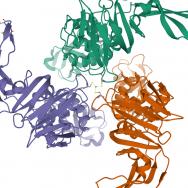The immigrant population is likely to be among the hardest hit by the coronavirus pandemic, as many struggle to access information, medical care and relief services. Clinical Profs. Nicole Hallett and Claudia Flores of the University of Chicago Law School recently discussed several key issues—including President Donald Trump’s announcement late Monday that he would temporarily halt immigration in the United States.
Directors of the Immigrants’ Rights Clinic and the International Human Rights Clinic, respectively, Hallett and Flores shared their thoughts on Trump’s impending executive order, the details of which had not yet been announced when they responded Tuesday morning. They also explained why they worry that the pandemic will have long-lasting effects on U.S. policy, how they think state, local and federal governments should address immigration issues during the crisis, and why fear among immigrants could contribute to further spread of COVID-19.
Below is an excerpt of the discussion, edited for length and clarity.
The Trump administration has cited the pandemic in a number of policy decisions, first to rapidly return those attempting to enter the country illegally—and now, in the announcement that Trump will sign an order temporarily suspending immigration to the U.S. What is your reaction to this latest move, and do you see the potential for long-term changes to immigration policy?
Hallett: This administration has tried to cut back on the right to asylum, and immigration in general, at every single opportunity. While some limitation on movement across borders may be necessary in the short term to mitigate the spread of the virus, it now appears that Trump plans to use this crisis to accomplish his anti-immigration goals writ large. The ban on immigration that Trump announced would be disastrous for asylum seekers, families trying to reunite and businesses who need high-skilled workers from abroad. The question in my mind is whether these changes will truly be temporary. After this pandemic ends, it’s likely we will face another one at some point in the future. It’s not a huge stretch to imagine the administration limiting entry ahead of time by saying that it wants to stop the spread of communicable disease. That would be catastrophic to the idea of the U.S. as a nation of immigrants.
Flores: I also worry about the current administration’s evident tendency to use the pandemic to justify insularity and isolationism. There is a different way to look at this, which is that we are all connected and interdependent members of a global community. This has been a test of how well the global community cooperates and communicates, and how strong our international legal infrastructure is around pandemics and related issues. Instead, our administration has decided to focus on an illusory solution of isolation. It’s a harmful and ineffective policy direction.
What are the factors that make the immigrant population particularly vulnerable during this pandemic?
Flores: One of the main issues is their ability to engage with the state. They’re more isolated and aren’t necessarily receiving the same information about what they’re supposed to do and where they can find help. And even if they have the information about services, there’s the issue of access. Immigrants—especially those who are undocumented or have someone in their family in an irregular immigration status—are less likely to seek assistance when they get sick or need help with employment or housing. In addition, we limit which services are available to individuals in irregular or temporary immigration status.
Immigration and Customs Enforcement (ICE) has said it won’t arrest undocumented immigrants seeking medical care during the pandemic. Still, fear remains a powerful factor preventing immigrants—especially undocumented individuals—from seeking medical care, which can endanger those individuals and contribute to the continued spread of the virus. What are some of the roots of this fear?
Hallett: We’re entering this pandemic after three years of very aggressive immigration enforcement, and the fear is very high. Yes, ICE has said that they will not arrest individuals seeking care for coronavirus-related concerns—but they included an important and broad exception: when those arrests are “mission critical.” But the mission of ICE over the last three years has been to deport as many people as possible. ICE was always supposed to limit its enforcement in hospitals and at doctor’s offices, but in the past three years, there have been many stories of ICE officers going into hospital rooms and making arrests. So people are still unsure and afraid.
There are also concerns about the new public charge rule, which means it will be harder to get a green card if you’ve accessed public benefits. The USCIS (U.S. Citizenship and Immigration Services), which issues green cards, has said it will make an exception for those who have accessed public benefits related to coronavirus, but immigrant communities are understandably still afraid because the rules keep changing. They don’t want to lose the ability to get status in the future.
What can be done at the city and state level to try to overcome some of these obstacles?
Hallett: It’s particularly important to reach out directly to immigrant communities to explicitly say that they will be safe if they come forward and seek medical care. Cities and states can also step in to make sure that all residents, including undocumented and documented immigrants, have access to a safety net during what could be quite an extreme economic recession.
Flores: The government needs to send a very clear message that it is prioritizing the ability to quell the COVID-19 pandemic. The immigrant community needs to understand that this is not the usual course of business and that there are a different set of rules in place now that will allow them to better participate and benefit from available state services. In the longer term, the state needs to find ways to engage with the immigrant community more productively.
How can officials go about getting that message to immigrant communities in a way that can be heard and, more importantly, believed?
Flores: They can send the message by their actions rather than relying solely on words—pulling back on current, often draconic, measures to control and limit immigration. As long as the government continues to put families in detention, pursue criminal prosecutions, and limit the availability of basic benefits, it’s going to be difficult for immigrant communities to believe that the government has their best interests in mind, even in this time of community crisis.
There have been reports of COVID-19 cases at federal immigration detention centers, as well as growing worries about even larger outbreaks. Last week, federal judges ordered the release of several men from the Jerome Combs Detention Center in Kankakee, Illinois, citing their vulnerability to the disease. What steps should officials take to keep detainees safe from COVID-19—and under what circumstances should detainees be released?
Hallett: Carceral environments are just about the worst possible place to be right now. We know that the only way to stop the spread of this virus until we have a vaccine is social distancing—and social distancing is impossible in carceral environments. Most immigration detainees either have never been convicted of a crime, or they’ve served their time. Very, very few of them are dangerous. We can have a larger discussion about whether immigration detention is appropriate in general, but right now we should be thinking about whether it is appropriate in this environment. In most cases, the calculus should come out in favor of release. That isn’t to say that there aren’t a few immigrant detainees who should be detained for public safety reasons, but we should be thinking about who actually needs to be detained. There are lives on the line.
Flores: The policy justifications for continuing to engage in widespread immigrant detention just don’t exist. In the criminal justice context, there are significant concerns about the ability of U.S. prisons to provide basic health care, sanitation and hygiene. In immigrant detention facilities, the same concerns exist—and prior to the Trump administration’s decision to adopt a “no tolerance” approach to unlawful entry, many immigrants were not even placed in longer term detention. Under the Obama administration, we detained far fewer immigrants and had very high compliance rates with court appearances and orders of removal. We really can continue to enforce our immigration laws while allowing people to remain out of detention.
There are other ways to make sure that you don’t lose track of people—telephonic check-ins and other monitoring mechanisms. Instead, we’re using resources to create more congregate environments where the virus is most likely to spread. We also want to be careful with the solutions some detention facilities have implemented to combat the virus, which have involved measures with significant human rights implications, such as putting inmates into solitary confinement or limiting their access to educational services or outdoor exercise.
Undocumented immigrants aren’t eligible for benefits under the $2 trillion stimulus package, but in Chicago, Mayor Lori Lightfoot has issued an executive order granting undocumented immigrants and refugees access to city benefits, including through the small business loan program. How does Chicago’s response stack up against other jurisdictions? And what additional steps should be taken here and elsewhere to address the massive economic toll on immigrants?
Hallett: Chicago is doing it exactly right. I was so heartened to see Mayor Lightfoot take that step. I think the problem is that we are in this federal system, which is very balkanized. And so even if there are certain mayors or governors who are taking certain steps, the immigrant community as a whole is going to remain vulnerable both to getting sick and then not having the resources that they need to survive the economic fallout.
In terms of what could be done nationally, one country that has done something really interesting is Portugal. They issued a law allowing all immigrants to be treated as citizens for the duration of the pandemic with respect to accessing public benefits, employment, et cetera. Portugal recognized that there would be public health consequences if a group of residents was excluded from recovery efforts. The U.S. absolutely could be doing that. We could put a moratorium on deportations. We could put a moratorium on ICE arrests, and we could allow undocumented immigrants and other immigrants who aren’t otherwise eligible to access these benefits.
Undocumented immigrants aren’t eligible for the emergency funds made available in the most recent recovery act, but it is even worse than that. If there’s a single person in a family unit that doesn’t have a social security number, then that entire family is ineligible for the relief funds. So what that means is that you could have a family with one documented parent, one undocumented parent, and three children who are American citizens and none of them will be able to access those benefits.
We can fix that in the next recovery act. We need to acknowledge that this is a community, and that many of the people who aren’t receiving benefits are the same ones delivering our Amazon groceries or driving the Uber cars that take us to the hospital. They’re the farm workers who are continuing to put food on our table. We need them. This is a human rights concern, but it’s also just a practical concern. Our immigrant population is part of our community, and we have an obligation to take care of them.
—This story was first published by the University of Chicago Law School.


